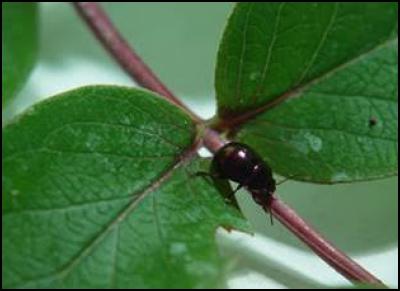Taking action against tutsan
Taking action against tutsan

Two insects that will tackle a weed threatening the viability of New Zealand farms are poised to be released into the environment for the first time.
A moth and a beetle, imported from Georgia, Eurasia, by Landcare Research in 2014, have tutsan (Hypericum androsaemum) in their sights.
This weed is thriving in parts of the central North Island, where it costs an estimated $400 per hectare per year to control.
The first public release of the beetle and moth will be made near Taumarunui on 15 February.
Landcare Research’s Hugh Gourlay says the release will be the culmination of nearly a decade of hard work.
“Tutsan is a threat to farmers’ livelihood and because of this they themselves have turned to science for a solution by forming TAG [Tutsan Action Group], a group of farmers who have dipped into their own pockets and joined forces with the likes of us, Landcare Research, Horizons Regional Council and the Sustainable Farming Fund, to come up with a solution.”
Landcare Research has established a world-class reputation in the field of biocontrol, saving New Zealand farmers millions of dollars.
Biocontrol offers a cost-effective, environmentally friendly and permanent solution to weed control. Carefully selected biocontrol agents target only weeds, don’t harm desirable plants and don’t pollute the environment. Once established, they travel wherever the weed is present and wherever it spreads, and can return again and again to kill off new weed growth – all without human input.
Gourlay is optimistic the foliage-eating beetle (Chrysolina abchasica) and the fruit, leaf and stem-feeding moth (Lathronympha strigana) will be as effective as other recent success stories, such as the ragwort flea beetle and St John’s wort beetle.
The latest two insects were approved for release by the Environmental Protection Authority in May, 2016, after an application was made by TAG.
Gourlay adds, “A rust (Melampsora hypericorum) was self-introduced into New Zealand several decades ago and controlled tutsan throughout the country, but the weed, for a variety of reasons, has taken off in recent years and we hope that by introducing some help in the form of these two new agents we can get this problem under control again.”
Recent research into tutsan populations in New Zealand has shown that the plant here has two distinct genetic types – one that grows in the North Island and another in the South Island. The North Island plants are not being controlled by the North Island rust anymore, whereas it appears that the other rust type is keeping the South Island plant populations under control.
Gourlay located both bugs in the former Soviet republic of Georgia in 2014 and brought them back into New Zealand, where he has reared them in Landcare Research’s state-of-the-art containment facility in Lincoln, which now hosts an insect population big enough to support releases of the moth and beetle into areas where the weed is flourishing.
Tutsan exists all over New Zealand but is a significant problem in parts of the central North Island, where it forms extensive patches that threaten agricultural, forestry and conservation land.
Unpalatable to stock, hard to kill and shade-tolerant, tutsan is particularly prevalent in areas where the land has been disturbed by the likes of forestry. It is easily spread by birds, mowers, machinery, and soil and water movement. Common seed sources include roadsides, conservation and wasteland, old gardens and forestry.
ENDS


 Greenpeace: Taranaki - Greenpeace Activists Stop Unloading Of Palm Kernel Sourced From Indonesian Rainforests
Greenpeace: Taranaki - Greenpeace Activists Stop Unloading Of Palm Kernel Sourced From Indonesian Rainforests Seafood New Zealand: Seafood Situation Saved By A Sausage - New Plymouth Locals Innovate, Using Crayfish Bait
Seafood New Zealand: Seafood Situation Saved By A Sausage - New Plymouth Locals Innovate, Using Crayfish Bait Takeovers Panel: Takeovers Panel Convenes Meeting To Inquire Into The Acquisition Of Shares In NZME Limited
Takeovers Panel: Takeovers Panel Convenes Meeting To Inquire Into The Acquisition Of Shares In NZME Limited WorkSafe NZ: Conveyor Belt Death-Trap Was A Danger In Plain Sight
WorkSafe NZ: Conveyor Belt Death-Trap Was A Danger In Plain Sight Commerce Commission: 2degrees Fined $325,000 For Misleading Claims About ‘Free’ Aussie Business Roaming
Commerce Commission: 2degrees Fined $325,000 For Misleading Claims About ‘Free’ Aussie Business Roaming  Natural Hazards Commission: Hub Launched To Empower Architects And Engineers To Build Above Code
Natural Hazards Commission: Hub Launched To Empower Architects And Engineers To Build Above Code



